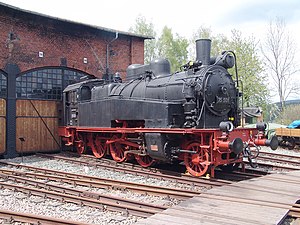Saxon XIV HT
This article includes a list of general references, but it lacks sufficient corresponding inline citations. (September 2016) |
| Saxon Class XIV HT DRG/DR Class 75.5 | |||
|---|---|---|---|

| |||
| Manufacturer: | Sächsische Maschinenfabrik, Chemnitz | ||
| Numbering: | 1801–1850 75 511–550 |
1851–1855 75 501–505 |
1856–1906 75 551–588 |
| Built: | 1911–1915 | 1915 | 1917/18, 1921 |
| Retired: | by 1970 | ||
| Quantity: | 50 | 5 | 51 |
| Wheel arrangement: | 2-6-2T
| ||
Axle arrangement : |
1′C1′ h2t | ||
| Track gauge: | 1,435 mm (4 ft 8+1⁄2 in) | ||
| Length over buffers: | 12,415 mm (40 ft 8+3⁄4 in) | ||
| Fixed wheelbase: | 2,800 mm (9 ft 2+1⁄4 in) | ||
| Overall wheelbase: | 8,700 mm (28 ft 6+1⁄2 in) | ||
| Empty weight: | 60.1 t | 62.7 t | 64.2 t |
| Service weight: | 76.7 t | 79.4 t | 82.2 t |
| Adhesive weight: | 47.7 t | 48.8 t | 49.5 t |
| Axle load: | 15.9 t | 16.3 t | 16.5 t |
| Top speed: | 75 km/h (47 mph) | ||
| Indicated Power: | 990 PS (730 kW; 980 hp) | ||
| Driving wheel diameter: | 1,590 mm (5 ft 2+5⁄8 in) | ||
| Carrying wheel diameter: | 1,065 mm (3 ft 5+7⁄8 in) | ||
| Valve gear: | Walschaerts (Heusinger)
| ||
| No. of cylinders: | 2 | ||
Cylinder bore : |
550 mm (21+5⁄8 in) | ||
Piston stroke : |
600 mm (23+5⁄8 in) | ||
| Boiler overpressure: | 12 kg/cm2 (1,180 kPa; 171 psi) | ||
| No. of heating tubes: | 132 | ||
| Heating tube length: | 4,000 mm (13 ft 1+1⁄2 in) | ||
| Grate area: | 2.30 m2 (24.8 sq ft) | ||
| Radiative heating area: | 11.8 m2 (127 sq ft) | ||
| Tube heating area: | 110.5 m2 (1,189 sq ft) | 119.8 m2 (1,290 sq ft) | 110.5 m2 (1,189 sq ft) |
| Superheater area: | 36.2 m2 (390 sq ft) | 65.0 m2 (700 sq ft) | 36.2 m2 (390 sq ft) |
| Evaporative heating area: | 122.3 m2 (1,316 sq ft) | 131.58 m2 (1,416.3 sq ft) | 122.3 m2 (1,316 sq ft) |
| Water capacity: | 8.0 m3 (1,800 imp gal) | 8.0 m3 (1,800 imp gal) | 9.0 m3 (2,000 imp gal) |
| Coal capacity: | 2.5 t | 2.5 t | 2.8 t |
| Brakes: | Westinghouse compressed-air brake
| ||
The Saxon Class XIV T locomotives were six-coupled
History
As a successor to the four-coupled Saxon Class IV T the Sächsische Maschinenfabrik in Chemnitz developed a six-coupled tank locomotive. This new engine was primarily intended to be used in charge of suburban trains in the big conurbations.
From 1911 to 1921, 106 of these locomotives, built in three series, were placed in service by the Royal Saxon State Railways. At the time of its appearance, the Saxon XIV HT was the heaviest 2-6-2 in central Europe. Not only were these locomotives used to haul suburban services, but in the end they were put in charge of all types of passenger trains on branch and main lines in Saxony's central mountains.
After
The locomotives left in Poland later went into the
After the end of
Two locomotives have been preserved: number 75 501 by the
Technical features
The locomotives had a
The steam engine itself comprised a two-
The
A Westinghouse
Nine cubic metres of water were carried in two side tanks and a well tank located in the frame. The coal bunker was behind the driver's cab.
For branch line duties, all machines were equipped with a steam-operated bell.
See also
- Royal Saxon State Railways
- List of Saxon locomotives and railbuses
References
- ^ Davies 2001, p. 37.
- Davies, John (August 2001). Chemins de fer de l'État Locomotive List 1878–1938. Woodbridge, Queensland: Dr. John Davies. ISBN 0-7316-8442-7.
- Hütter, Ingo (2021). Die Dampflokomotiven der Baureihen 60 bis 91 der DRG, DRB, DB, und DR (in German). Werl: DGEG Medien. pp. 160–167. ISBN 978-3-946594-21-5.
- Näbrich, Fritz; Meyer, Günter; Preuß, Reiner (1983). Lokomotivarchiv Sachsen 2 (in German). Berlin: Transpress VEB Verlag für Verkehrswesen.
- Preuß, Erich; Preuß, Rainer (1991). Sächsische Staatseisenbahnen (in German). Berlin: Transpress Verlagsgesellschaft mbH. ISBN 3-344-70700-0.
- Reiche, Günther (1998). Richard Hartmann und seine Lokomotiven (in German). Oberbaumverlag Berlin/Chemnitz. ISBN 3-928254-56-1.
- Vandenberghen, J. (1989). La guerre 1914 - 1918 et les locomotives "Armistice", 3. Description des locomotives bavaroises, saxonnes, badoises, mecklebourgeoises, oldenbourgeoises (PDF) (in French). Brussels: SNCB. p. 39.
- Weisbrod, Manfred; Müller, Hans; Petznik, Wolfgang (1978). Dampflokomotiven deutscher Eisenbahnen, Baureihe 60–96 (EFA 1.3) (in German) (4th ed.). Düsseldorf: Alba. pp. 78–80. ISBN 3-87094-083-2.

